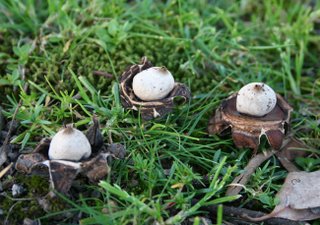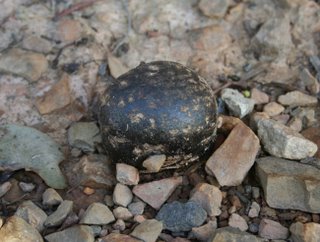Puffballs come in all shapes and sizes. You might be familiar with the big, round soft puffballs (such as Lycoperdon), which release spores through a pore whenever they're touched. But these aren't the only sort.
 Earth stars (Geastrum) are also puffballs. Each starts off as a sphere. As it grows, the outer layer peels away into neat segments to reveal the spore-sac. In some species, the segments fold back so far they raise the fungus off the ground.
Earth stars (Geastrum) are also puffballs. Each starts off as a sphere. As it grows, the outer layer peels away into neat segments to reveal the spore-sac. In some species, the segments fold back so far they raise the fungus off the ground. The horse dung fungus (Pisolithus) is often overlooked. After all, who gives horse poo a second glance? (That's a rhetorical question. Please don't send your answers to me.) Forget the unprepossessing appearance because Pisolithus is an important ectomycorrhizal fungus. It forms mutualistic associations with a wide range of plants, infiltrating the host's roots (in a good way) and providing it with nutrients. Pisolithus is easy to culture, so is widely used in forestry to help tree growth.
The horse dung fungus (Pisolithus) is often overlooked. After all, who gives horse poo a second glance? (That's a rhetorical question. Please don't send your answers to me.) Forget the unprepossessing appearance because Pisolithus is an important ectomycorrhizal fungus. It forms mutualistic associations with a wide range of plants, infiltrating the host's roots (in a good way) and providing it with nutrients. Pisolithus is easy to culture, so is widely used in forestry to help tree growth. Read more
Anderson. I. (2000). Inter- and intraspecific variation in Pisolithus from central and eastern mainland Australia. PhD thesis, University of Western Sydney. (Thesis available as PDFs)
Fungimap, the place for fungi fans in Australia
CSIRO's site on ectomycorrhizal fungi
Tom May on identifying earth stars
[Thanks to Randall, who found these specimens on a fungus foray on his property NE of Melbourne.]